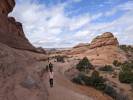Bryce Canyon hoodoos inspire Utah author to write children’s book
As a science writer, often of children’s books, Terry Jennings has a thing for erosion. But she wagered she wouldn’t have an easy time getting kids excited about the force responsible for many of the rock formations in Southern Nevada, Utah and Arizona.
“(It) can be a destructive force, but also a force that creates beautiful things,” Jennings said.
After reading about the Paiute legend of the hoodoos on a trip to Bryce Canyon National Park in Utah, she knew she had the hook that would make the topic interesting and relevant to children. Hoodoos are the tall, thin rock formations that Bryce Canyon is known for.
Jennings released the book, “Vivian and the Legend of the Hoodoos” (Arbordale Publishing, $17.95), in February. Vivian goes with her grandmother to pick pine nuts on the mesa. When the young girl, impatient for her basketball tryouts later that day, begins showing disrespect to the trees they’re picking the nuts from, her grandmother explains the significance of the traditional Paiute practices to Vivian. The final pages explain the natural process that results in the rock towers.
Jennings, who lives in St. George, Utah, from January through April and the rest of the year in Reston, Virginia, wrote the book in consultation with members of the Shivwits Band of Paiute Indians, who live in the southwest corner of Utah near St. George.
Glenn Rogers, a Shivwits council member whom Jennings worked with on the book, appreciates that she reached out to the tribe to verify the details of the Paiute culture, because many writers before her had not. “People bring out books and they assume what this means and they assume what that means,” Rogers said.
In Jennings’ research, she confirms facts about the legend itself, the details of the Paiute’s pine nut collection and the relationship between grandmother and granddaughter. “I wanted to make sure that anything that I said was met with their approval. It was actually a good thing that I wanted to do that because they made my story so much richer,” Jennings said.
One facet of Paiute culture that Rogers emphasized in his conversations with Jennings was the meaning of the word “hoodoo.” In the Paiute language, it refers to more than just the rock formations. “Hoodoo” can be used to refer to the unknown, another being or spirit, or a place that you can hide behind. It can also be an expression of fear. In the book, Vivian’s grandmother used the term to scare her into obeying.
Jennings relies on her own background coming to the U.S. from Cuba at 12 years old to depict universal experiences of being a kid in a story that both Paiute and non-Paiute children can understand.
“I want kids to identify with the fact that whether you’re Native American, whether you’re Cuban, whether you’re Pakistani or Lebanese, whatever, Chinese, you are a human being and all these kids are wanting to do the same things,” Jennings said.





























